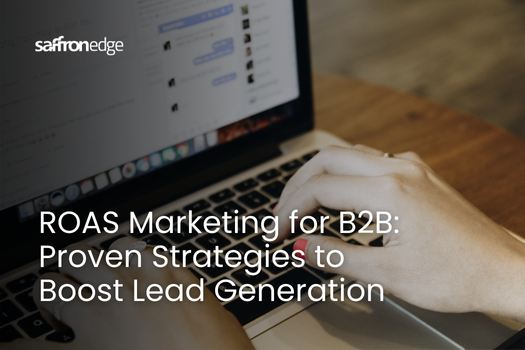ROAS Marketing for B2B: Proven Strategies for Higher Returns in 2025
Even after spending on ad campaigns, businesses don't see the results. Are you experiencing the same? If your ad campaigns aren’t delivering the expected revenue, it’s time to focus on Return on Ad Spend (ROAS).
If you invest in paid ads through platforms like Google Ads, Facebook Ads, LinkedIn Ads, or Instagram Ads, tracking ROAS can help you optimize your campaigns, allocate budgets efficiently, and maximize profitability.
This blog will cover everything you need to know about ROAS, including its definition, importance, calculation, industry benchmarks, and actionable ways to improve it.
What is ROAS?
ROAS (Return on Ad Spend) is a key performance indicator (KPI) that measures the revenue generated from advertising spend. It helps businesses determine whether their ad campaigns are profitable or need optimization.
ROAS = Revenue from Ads / Ad Spend
Marketers track organic ROAS to compare marketing efforts, but it’s harder to measure due to multiple factors. In contrast, paid campaigns are easier to track through ad platforms. You can also get immediate results with our Google Ad consultancy services.
For B2B companies, measuring ROAS is more complex than in B2C due to:
-
Longer sales cycles requiring nurturing before conversion
-
Higher acquisition costs due to competitive bidding on platforms like LinkedIn
-
Multiple stakeholders involved in decision-making
The table below shows the average ROAS marketing performance across different channels:
Average ROAS by Channel
For Paid Channels:
| Channel | ROAS |
|---|---|
| PPC/SEM | 1.55 |
| Online PR | 1.6 |
| Facebook Ads | 1.8 |
| Influencer Marketing | 3.45 |
| LinkedIn Ads | 2.3 |
For Organic Channels:
| Channel | ROAS |
|---|---|
| SEO | 9.1 |
| Email Marketing | 3.5 |
| LinkedIn Organic | 2.75 |
| Webinars | 4.95 |
Why ROAS Matters in B2B?
ROAS is one of the most critical performance metrics for B2B businesses running digital ad campaigns. It provides actionable insights that help optimize advertising efforts.
Here’s why ROAS is essential for every business:
1. Measures Ad Effectiveness
ROAS helps businesses determine whether their ads generate enough revenue to justify ad spending.
2. Optimizes Budget Allocation
A high ROAS marketing performance means your ad spend is being used efficiently. By analyzing ROAS across different campaigns, businesses can shift their budget toward the highest-performing ads.
3. Helps Refine Targeting and Strategy
If your ROAS is low, your targeting, ad copy, or offer might need improvement.
4. Increases Business Growth
By maximizing ROAS, companies can reinvest in high-performing campaigns, leading to higher revenue and long-term growth.
5. Evaluate the Performance of Different Ad Channels
ROAS allows businesses to compare ad performance across platforms like Google, Facebook, LinkedIn, and TikTok to determine the most profitable ones.
How do you calculate ROAS?
Return on Ad Spend is calculated by dividing your Conversion Value (revenue) by your Spend.
The formula to calculate ROAS is:
ROAS = Total Revenue from Ad Campaign/ Campaign Spend
Revenue from Ads: How much money you’ve made from your conversions.
Example Calculation:
-
Suppose you spend $2,000 on Google Ads.
-
Your campaign generates $8,000 in revenue.
-
Your ROAS = $8,000 ÷ $2,000 = 4:1 (or 400%)
-
This means that for every $1 spent, you earned $4 in return.
What are the Pros and Cons of using ROAS?
Pros of ROAS
1. Identifies Profitable Campaigns
ROAS helps businesses track which ads are driving the most revenue. By analyzing ROAS, businesses can:
-
Identify which platforms (Google Ads, Facebook, LinkedIn, etc.) generate the highest returns.
-
Stop investing in underperforming campaigns.
-
Scale up high-ROAS campaigns to maximize profits.
For example, increasing the budget could drive more sales if a Google Ads campaign has a ROAS of 6:1 (earning $6 for every $1 spent).
2. Optimizes Ad Spend
Companies can use ROAS to reallocate budgets toward more profitable ads. Instead of spending evenly across all campaigns, they can:
-
Increase spending on high-performing ads.
-
Pause or modify low-ROAS campaigns.
-
Experiment with ad formats and targeting to improve efficiency.
Say, if a Facebook ad targeting young professionals has a ROAS of 2:1, while an ad targeting small businesses has a ROAS of 5:1, shifting more budget to the second audience can improve overall returns.
3. Improves Decision-Making
ROAS provides quick insights that help businesses make data-driven decisions, such as:
-
Adjusting bids on keywords in Google Ads.
-
Refining audience targeting based on performance.
-
Testing different ad creatives and copy.
4. Provides Quick Performance Insights
-
Get instant feedback on which ads are working.
-
Make quick adjustments to improve efficiency.
-
Test multiple campaigns and optimize in real-time.
For example, an ecommerce store running Black Friday ads can check ROAS daily to decide whether to increase ad spending for better sales.
Cons of ROAS
1. Does Not Show True Profitability
ROAS only measures revenue generated from ad spend but does not factor in other costs associated with running a business.
Even if an ad campaign has a high ROAS, a business could still be unprofitable if its overall costs are high.
2. Ignores Customer Lifetime Value (LTV)
ROAS focuses only on immediate revenue from an ad campaign without considering whether customers will make repeat purchases in the future.
This can lead businesses to undervalue ads that attract high-quality, long-term customers.
3. Varies by Industry
What’s considered a "good" ROAS depends on the business type, making it unreliable as a universal success metric.
Example:
-
Ecommerce brands typically aim for a ROAS of 4:1 or higher because they rely on direct sales.
-
Subscription businesses may accept a ROAS of 2:1 because they recover costs over time through recurring revenue.
-
Luxury brands may have low ROAS but high-profit margins, making their campaigns successful despite lower ad efficiency.
Your Ad Spend Deserves Better Results
We help you unlock high-performing B2B campaigns with data-driven ROAS marketing. Optimize, scale, and convert with precision.
9 Key B2B ROAS Marketing Strategies
1. Improve Audience Targeting
Your ads will only perform well if they reach the right audience. Targeting a broad or unqualified audience can waste ad spend and lower ROAS.
To improve targeting:
-
Use demographic targeting (age, gender, location, income) to reach your ideal customers.
-
Leverage interest-based targeting in platforms like Facebook and Google Ads to focus on people who engage with similar brands.
-
Use behavioral targeting by analyzing past website visitors and purchase history.
-
Implement lookalike audiences to find new users similar to your best customers.
2. A/B Test Ad Creatives
Testing different elements helps identify which headlines, images, videos, and CTAs resonate most with your audience.
-
Test different headlines (question-based, benefit-driven, urgency-based).
-
Experiment with varied CTAs (e.g., “Shop Now” vs. “Get Yours Today”).
-
Compare static images vs. video ads to see which drives better engagement.
-
Use different ad formats (carousel, single image, slideshow) to test performance.
3. Optimize Landing Pages
Even the best ad won’t drive sales if your landing page is slow, unresponsive, or not persuasive. A poor landing page experience increases bounce rates and lowers ROAS.
How to optimize landing pages:
-
Improve page load speed (Google recommends under 3 seconds).
-
Ensure mobile-friendliness, as over 50% of traffic comes from mobile users.
-
Use a clear headline and CTA to guide visitors toward conversion.
-
Reduce distractions by keeping the design clean and eliminating unnecessary links.
-
Add trust signals (customer reviews, security badges) to increase confidence.
4. Adjust Bidding Strategies
The wrong bidding method can lead to high ad spending with little return.
Best bidding strategies for ROAS:
-
Use Target ROAS bidding in Google Ads to automatically adjust bids for better returns.
-
Choose Maximize Conversions to get the most conversions within your budget.
-
Utilize manual CPC (cost-per-click) bidding if you want full control over bid adjustments.
-
Adjust bids based on device performance, prioritizing platforms that drive more conversions.
5. Focus on High-Performing Keywords
Not all keywords are profitable in search advertising. Some drive traffic but result in low conversions, wasting your budget.
To improve keyword strategy:
-
Identify high-ROAS keywords and increase bids on them.
-
Pause or remove low-performing keywords that generate clicks but no conversions.
-
Use negative keywords to prevent wasting spend on irrelevant searches.
-
Focus on long-tail keywords, which tend to have lower competition and higher conversion rates.
6. Use Retargeting Ads
Most visitors don’t convert on their first visit but may be interested in your product. Retargeting ads bring them back and increase conversion rates.
How to use retargeting:
-
Retarget users who abandoned their cart with discount or reminder ads.
-
Show personalized product recommendations based on what they viewed.
-
Use dynamic remarketing to display the exact products visitors showed interest in.
-
Set frequency caps to avoid ad fatigue and prevent annoying potential customers.
7. Optimize for Mobile Users
With over 50% of online traffic coming from mobile devices, businesses that don’t optimize for mobile lose potential customers and lower ROAS.
How to Improve Mobile Experience:
-
Use mobile-friendly ad creatives (larger fonts, vertical video, thumb-friendly CTAs).
-
Avoid long forms and simplify checkout for faster mobile conversions.
-
Make sure buttons and links are easy to click on smaller screens.
8. Shift Budget to High-ROAS Channels
Some advertising platforms perform better than others, depending on the business and audience. Tracking channel performance helps allocate the budget effectively.
How to allocate budget wisely:
-
Identify top-performing platforms (Google Ads, Facebook, TikTok, LinkedIn) based on your industry.
-
Reduce spend on low-ROAS channels that don’t drive conversions.
-
Increase investment in ads with the highest engagement and conversion rates.
-
Use multi-channel attribution to see how different channels contribute to overall sales.
9. Leverage Video & Dynamic Ads
Video and interactive ads often drive higher engagement and conversion rates than static images.
How to use video & dynamic ads effectively:
-
Use short, engaging videos (under 30 seconds) to capture attention quickly.
-
Test carousel ads to showcase multiple products in a single ad.
-
Implement dynamic product ads (DPA) that automatically display the right products to the right audience.
-
Add captions to video ads since many users watch on mute.
10. Target High-Intent Audiences
Instead of broad targeting, focus on decision-makers and high-intent users actively searching for solutions.
How to implement:
-
Use LinkedIn Matched Audiences to retarget website visitors and CRM contacts
-
Run Google Search Ads with high-intent keywords
-
Leverage Account-Based Marketing (ABM) to target specific companies
Outcome: Higher-quality leads with a better chance of conversion.
12. Implement Multi-Touch Attribution for ROAS Optimization
Since B2B leads interact with multiple touchpoints, tracking every touchpoint is essential.
Multi-Touch Attribution Models:
-
First-Touch Attribution – Credit goes to the first interaction
-
Last-Touch Attribution – Focuses on the final conversion source
-
Linear Attribution – Distributes credit evenly across all touchpoints
-
Data-Driven Attribution – Uses AI to assign value to touchpoints
Outcome: More accurate insights into what’s driving revenue, allowing smarter budget allocation.
Why Choose Saffron Edge for ROAS Marketing in B2B?
Saffron Edge specializes in data-driven B2B marketing to help companies optimize ROAS and drive high-value conversions. Our approach includes:
-
Advanced Audience Targeting: Identifying and reaching decision-makers with precision
-
AI-Powered Ad Optimization: Running smart campaigns with AI-driven insights
-
Conversion-Focused Landing Pages: Custom-built for maximum lead generation
-
Attribution Modeling Expertise: Multi-touch tracking to measure campaign impact
-
Full-Funnel B2B Strategies: Combining paid ads with email, SEO, and content marketing
Through data-backed marketing strategies, we help businesses reduce wasteful ad spending, improve conversion rates, and achieve sustainable growth.
Frequently Asked Questions
What is a good ROAS
A good ROAS depends on your industry, but generally, ecommerce businesses aim for a ROAS of 4:1 or higher, while lead generation campaigns perform well within the 3:1 to 5:1 range. SaaS and subscription models typically target a 3:1 ROAS, considering the long-term customer value, whereas retail and consumer goods businesses often achieve a ROAS between 4:1 and 8:1. If your ROAS is below 2:1, it’s a strong indicator that your campaigns need optimization.
How can I track ROAS?
Tracking ROAS requires using analytics platforms like Google Ads, Facebook Ads Manager, and Google Analytics. By setting up proper conversion tracking, businesses can measure their ROAS marketing performance accurately and make data-driven decisions to enhance their advertising efficiency.
Does ROAS include all business costs?
ROAS only accounts for ad spend and the revenue generated from those ads. It does not factor in additional business expenses such as production, labor, or overhead costs. To gain a comprehensive understanding of profitability, businesses should track ROI alongside ROAS.
Why is my ROAS low, and how can I fix it?
A low ROAS is often caused by poor audience targeting, weak ad creatives, slow-loading landing pages, or inefficient bidding strategies. Businesses can improve their ROAS by refining audience segmentation, A/B testing different ad creatives, optimizing landing page speed and content, and leveraging smart bidding strategies such as Target ROAS or Maximizing Conversions.
What’s the difference between ROAS and CPA (Cost Per Acquisition)?
ROAS measures the revenue generated for every dollar spent on ads, while CPA calculates the cost of acquiring a customer or lead. A high ROAS combined with a low CPA indicates that ads perform efficiently and deliver a strong return on investment.
Struggling to Maximize Your B2B Marketing ROI?
At Saffron Edge, our performance marketing experts understand your target audience end-to-end to optimize your ad spending with proven ROAS strategies that drive more leads and revenue while reducing waste.
Share with Friends
Get The Ultimate Marketing Toolkit
100+ Tools on SEO, Google Ads, Meta Ads, Social Media, and more for B2B Brands.
Free DownloadSubscribe to our newsletter
Get fresh stories, case studies, and
advice
from successful creators and industry experts.

Subscribe now

Get The Ultimate Marketing Toolkit
100+ Tools on SEO, Google Ads, Meta Ads, Social Media, and more for B2B Brands.
Free Download






